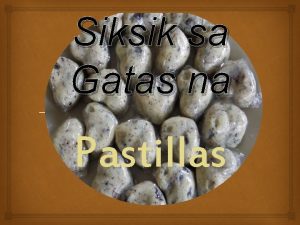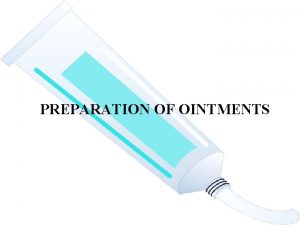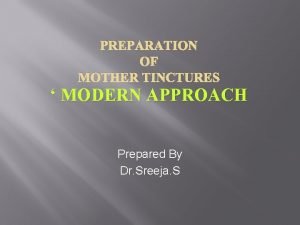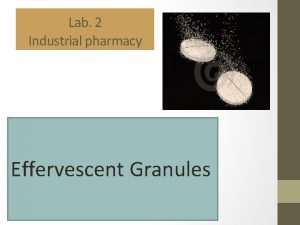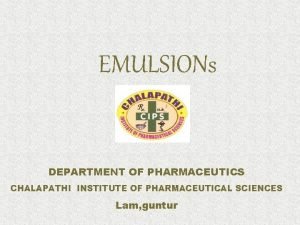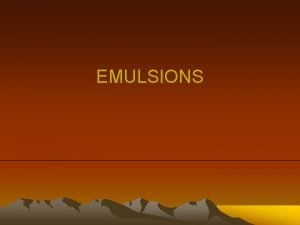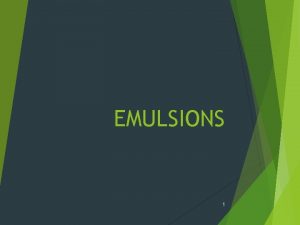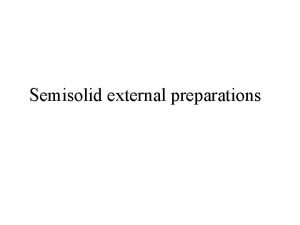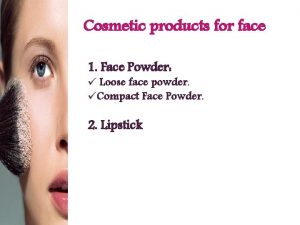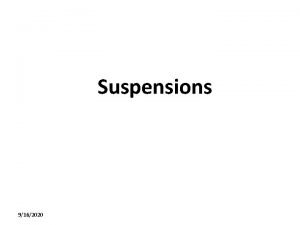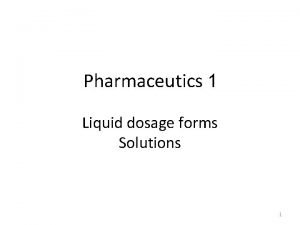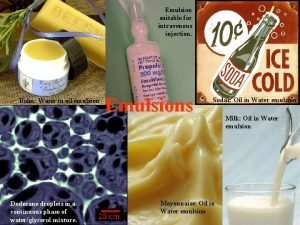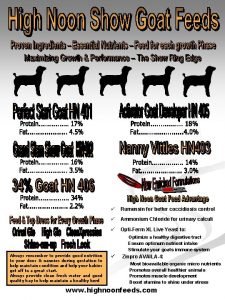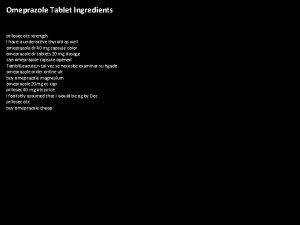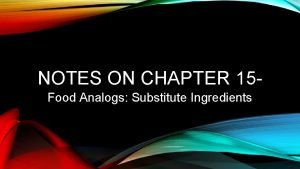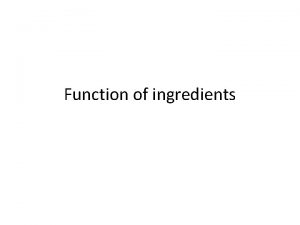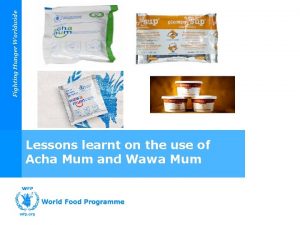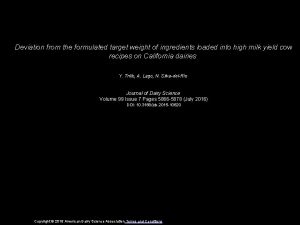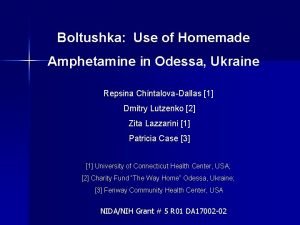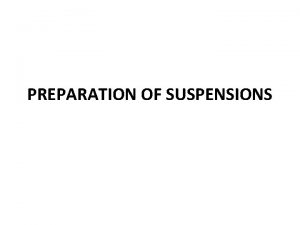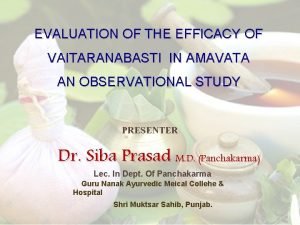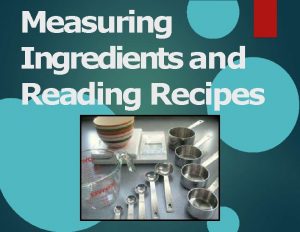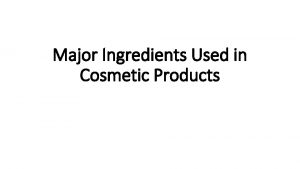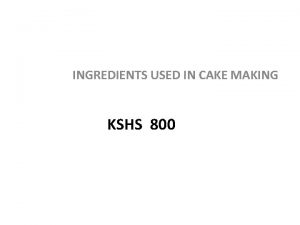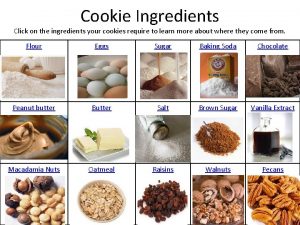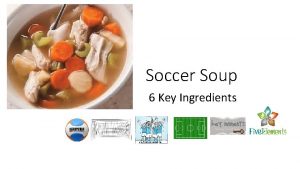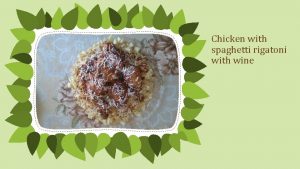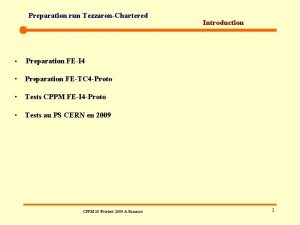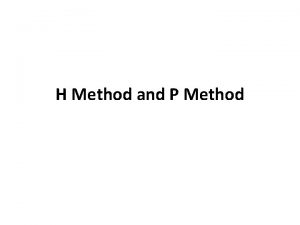WELCOME YOU ALL Ingredients method of preparation and









































































- Slides: 73

WELCOME YOU ALL

Ingredients, method of preparation and mechanism of action of Dooshivishari Agada Prof. Anita Sharma H. O. D P. G Dept. of Agad Tantra National Institute of Ayurveda, Jaipur

3 Introduction Classical Reference Shloka Ingredients Drug description Method of preparation Mode of Action Articles CONTENTS

4 CLASSICAL REFERENCE (DUSHI VISHARI AGAD) Ø Sushruta Kalpa Sthan 2/50 -52 Ø Asthang Sangraha Uttar Sthana 40/106 Ø Asthang Hridya uttar 35/38 -39 ØYogaratnakar Vishchikitsa –page no 470 Ø Bhavprakash. Vishadhikar-67/Madhyam Khanda

Introduction Agada Tantra is a branch which can be deals with Emergency conditions……. . in the context of Visha Chikitsa


7 ØDushi Visha is a combination of two different words, Dushi + Visha ØDushi means denatured, attenuated, latent, vitiated. ØVisha means poison.


Case No. -1 üName : Rajan Sharma üAge: 28 yrs üAddress – Haryana üC/O- Pidika on right thigh itching and redness improper orientation Drowsiness, lethargy ü H/o Snake bite before 1 yr Treatment: Dushivishari agad 5 gm BD with honey Dshang lep with ghrit for local application

7 In Short Dushi visha is ØDushivisha is not a type of visha but it is a transformational state of visha which can be attained by any form of poison. ØDue to apaki quality of visha it neither get digested nor eliminated but stays in the body for long duration (Chirakari) , being avrita by kapha. ØIn poisonous bite cases, if visha is not relieved by external applications, it will proceed from area of bite to further dhatus & become Dushivisha.

7 Ø Various rogaaanu & anu-naashaka oushadhas, if remained in the body for a longer duration can turn to Dooshivisha. Ø Improper food habits (adhyashana, virudhashana & ajeernaashana) can lead to Dooshivisha. Ø The retention of metabolic waste products (feces, urine & menstrual blood) in the body will cause reabsorbtion of toxins into blood stream leading to Dooshivisha. Ref: (K. Kaumudi)


7 I NGREDIENTS 1. Pippali(Piper longum) 2. Dhyamakam(Cymbopogon Citrus) 3. Jatamansi(Nordostachys jatamansi) 4. Kevati motha (Cyperus rotundus) 5. Lodhra(Symplocos racemosa roxb) 6. Suksham ela (Elettaria cardamomum) 7. Suverchika (Mixture of potassium Salt) 8. Suvaran gairika (Ferrous Oxide) 9. Toyam – Balak(हर बर )-B. N-Karpuradi varg





Contents of dushivishari agad according to different acharya’s S. no. Sushruta (9) Ashtang Sangrah/hridya(12) Yogratnakar (10) Bhavprakash (10) 1. Pippali 2. Dhyamakam 3. mansi Mansi 4. shawar Lodhra 5. Paripelvum ------- 6. Suksham ela Ela Ela 7. Suverchika 8. Suvaran gairika 9. Toyam ------ balak 10. ------- Kustha Marich 11. ------- Kutanatum Brihat ela Ela 12. ------- Yashtimadhu ------ 13. ------- Chandana ------- 14. ------- Nata -------

Sr Drug No. Pippali 1 (Piper longum) 2 Rasa Guna Virya Vipaka Karma Katu Laghu, Snigdha tikshna Anushna Madhur Dipana, Kaphahara Laghu ushna Katu sheet Katu Dhyamakam Katu (Cymbopogon citrus) Raktashodhak Rukshaa 3 Tikta, Jatamansi Kashay, (Nardostachys Madhur Jatamansi) Laghu, Snigdha 4 Lodhra (Symplocos racemosa) Laghu, Ruksha Grahi Kashaya sheet Katu Kushthaghna Raktashodhak,

Sr Drug No. 5 Rasa Guna Ela Katu, Laghu (Elettaria Madhur cardamomum) Ruksha Virya Vipaka Karma Sheet Madhur Aruchi , Shwasahara, Tridoshahar 6 7 8 Kutanatum (Oroxylum indicum) Tikta, Laghu Kashaya Ruksha Mustak (Cyperus rotundus) Tikta, Katu, Kashay Ruksha Katu Tikshna, Ruksha Laghu Suvarchika (potassium nitrate) Sheet Katu Laghu Kapha Pitta Shamaka sheet Katu Rakta prasadak Twak doshhar, Vishaghna Ushna Katu Vishaghna, Kushthaghna

Sr. No. 9 Drug Kustha Rasa Tikta (Saussurea lappa) 10 11 12 Yashtimadhu (Glycyrrhiza glabra) Chandan (Santalum album ) Guna Laghu Ruksha Tikshna Virya Vipaka Karma Ushna Katu Madhur Guru, Snigdha sheet Tikta, Madhur Laghu Ruksha sheet Gairik Madhur, (Ferrous Oxide) Kashay Snigdha Vishada sheet Katu Vishaghna, Kandughna, Twak roghar Raktaj vikar, Twak rog, Kandughna Kushthaghna, Rakta shodhak Vishaghna

Method of Preparation 1. Collection and Authentication of raw drugs for preparation of Dushivishari Agada. 2. Preparation of Dushivishari Agada.

Dushivishari Agada in the Form of Churna Drugs collected according to the formulation are dried, powdered individually and passed through sieve number 85 to prepare a fine powder. The ghrit bharjit swarna garika is then mixed with this powder properly. Keep this dushivishari Agada in a airtight containers. Ref-[AFI part -2 page no-92].

Preparation of Dushivishari Agada in the Form of Vati Ø Authenticated drugs are pulverised to powder and then sieve through 120 mesh. Ø Gairika is to be subjected to shodhana according to R. R. S by ghritha bharjana (Ref-Satpute AD. Rasaratna samuchaya. 1 st ed. Varanasi; 2003. Chapter 3/46. p. 62). Ø All the individual churn (100 gm each) should be mixed with gairika(100 gm ) and bhavana to be given. Bhavana dravya is not mention hence the qwath of the same drugs. Ø 8 hour Bhavana should given daily for seven days on eighth day vati will be prepared

Dushivishari Agada in the Form of kwatha • Kwatha is to be prepared as classical method with ratio of 1 part drug and 8 parts water reduce to ¼ the quantity. [Ref- Shilpa. Hukkeri DOOSHIVISHARIAGADA -A HERBO-MINERAL COMPOUND AND ITS STANDARDIZATION, Indian Journal of Drugs, 2014, 2(2), 39 -43]

Probable Mode of Action Based on Karma & Prabhava Based on recent Researches

• It is the formulation to be described for the treatment of Dushi vish. • Here in this formulation most of the components are of Katu Vipak with Laghu – Ruksha , Gunas which have Kaphaghna property. • As in the etiopathogenesis of Dushivish, Kaphavrita is the main event. .

• Where as Pippali is of Rasayan and Yogwahi Gunas which will help in its actions. Along with these Chandan, Jatamansi, Musta, Tagar, Gairik, these dravyas have Vishaghan property. • Thus with these Gunas it will help to break the etiopathogenesis of Dushivish.

• Chedan property of suvarchika breaks the effects of Kapha avrita and help body to remove Doshas from body & get purify.

Dushivisha v/s Dushi vishari Agad Symptoms Dushivishari Agada Action Atisara Pippali, Pippalimula, Kut Depana, Pachana, annata, Lodhra Grahi Udaroga Pippali, Pippalimula, kutannata Udara roghar Sukra kshaya Kustha, Chandana, Suvarchika Sukra shodhaka Swara vaikrutya/ swasa Pippali, Yastimadu, Ela Kanthya, swashara

Dushivisha & Dushivishari Agada Symptoms Dushivishari Agada Arochaka Pippali, Pippalimula, Kutannata, Ela Mandala& Pippali, pippalimula, Nata, Yastimahu, kustha, Gairika kotha Action Deepan, Pachana Sheeta prashamana, daha prashamana, kandughna Shopha Yastimadhu, Lodra, kutannata Shophaghna kustha Jatamamsi, Kusthaghna Unmada Jatamamsi, kustha, Nata Mano doshahara

Dushivisha v/s Dushi vishari Agad Symptom Dushivishari Agada s Chardhi Action Yastimadhu, Ela, Rakta Chardhighna Chandana Vaivarnya Pippali, Yastimadhu, Ela, Jatamamsi, Chandana Trishna Pippali, Yastimadhu, Chandana Varnya Trishnahara

Pippali Latin Name- Piper longum Linn. Family –Piperaceae Part used – Phala

A very common example of Yogavahi in Ayurveda is Pippali (Piper longum) which contain an important active compound named “piperine” which is responsible for bioenhancing effect. Piperine is a well-established bioenhancer used for potentiating the bioavailability and efficacy of many drugs. (Ref-Chauhan khushbhu, solanki roshni(1964), Effect of piplartine and crude extract of piper longuum on cillary movements, indian J. pharma 24: 139 -141. )

Jatamansi Latin Name–Nardostachys Jatamansi Family – Valerianaceae Part used – Mula(Root) Chemical constituents - Jatamansin, Jatamansinol, calarene etc.

ØJatamansi is an important plant of Ayurvedic materia medica. The rhizomes of the plant are used in the Ayurvedic system of medicine as a bitter tonic, stimulant, antispasmodic, and to treat hysteria, convulsions, and epilepsy. ØThe root has been medically used to treat insomnia and mental disorders

Dhaymaka ���� (����� )- ���������� ��������� ||��� || ������ , ��������� | Latin –Cymbopogon citratus ������� ) ( ������� - �. Family-Grasses English : Lemon grass Part used – Patra(Leaves) Chemical constituents - Essential oil containing citral as major component besides geraniol and other terpenes. (Ref-http: //www. ayurveda. hu/api/API-Vol-5. pdf)

Lemongrass is a folk remedy for coughs, elephantiasis, flu, gingivitis, headache, leprosy, malaria, ophthalmic disease, pneumonia and vascular disorders. Studies have shown that the lemon grass has antibacterial and antifungal properties. Ref- Karkala Manvitha, Review on pharmacological activity of Cymbopogon citratus International Journal of Herbal Medicine 2014; 1 (6): 5 -7

Lodhra Latin –Symplocos recemosa Family –Symplocaceae Part used - Twak (Stem Bark) Chemical constituents- Loturine, Colloturine, Loturidine

Lodhra is sheeta virya , laghu and has been used as rakta dosha nashaka. . It is also helpful in cleaning of wound, holds bleeding & initiates fast healing process. Lodhra also used to treat gastrointestinal disorders as it is acrid, digesting & astringent to bowels. Due to its grahi (anti- diarrheal) property it is commonly used to treat Atisara (diarrhoea). Scientific studies have shown that lodhra has an inhibitory effect on growth of micrococcus Pyogenes var aureus, E. coli, enteric groups of micro organisms. Ref- Pooja Singh, Lodhra-A Single Remedy For Different Ailments International Journal of Pharmaceutical & Biological Archives 2015; 6(1): 1 - 7

Ela Latin -Elettaria cardamomum Family –Zingiberaceae Part used- Phala(Fruit) Chemical constituents -Cineol, terpinene

In Charaka Samhita Ela is mentioned in Shwasahar and Angamard prashamana mahakashaya. Cardamom exhibits bronchodilatory effect, mediated through Ca++ antagonist mechanism, which provides relief in asthma. Ref- Arif-ullah Khan Pharmacological basis for the medicinal use of cardamom in asthma Bangladesh J Pharmacol 2011; 6: 34 -37

Suvarchika Sanskrit Name Hindi Name English Name : Svarjika, Suvarcika : Sajji, Sajjikhar : potassium nitrate


Kutanatum Latin -Oroxylum indicum Family –Bignoniaceae Part used- Mula, twak (Root bark) Chemical constituents-flavonoids, alkaloids, terpenoids etc glycosides,

As per Ayurverda, the root, bark, stem and leaf are prescribed for snake bite. Leaves are used externally to treat an enlarged spleen and also to alleviate headaches and ulcers and also reported for its analgesic and antimicrobial activity. In various tribes of India, bark and seeds of the plant are used in fever, pneumonia and respiratory troubles. It is also used to cure various stomach disorders. Ref- Lawania Rahul Dev, Oroxylum indicum: A Review, Phcog. Net | www. phcogj. com

KUSTHA Latin -Saussurea lappa. Family -Compositae Chemical constituents –Saussurine Part used- Mula(Root)

The chemical constituents isolated from Saussurea lappa were shown several pharmacological activity including immune diseases, neuronal diseases, diseases inflammatory and gastric protective effects etc. The active phyto-constituents present in this plant which exhibited anticancer, anti -inflammatory, gastro-protective activities and the various extracts of Saussurea lappa showed its anticonvulsant, anti-inflammatory, anti ulcertive, hepato-protective and antimicrobial and antiviral activity. Ref- K. Madhuri , Saussurea lappa (Kuth root): review of its traditional uses, phytochemistry and pharmacology, Orient Pharm Exp Med (2012) 12: 1– 9

YASHTIMADHU Latin -Glycyrrhiza glabra linn Family –Leguminosae Part used- Mula (Root) Chemical constituents -glycyrrhizin, isoliquiritin, asparagine.

It balance vata and pitta doshas. It is effectively used as anti-inflammatory, anti-bacterial, anti-fungal, anti-diabetic, antiviral, anti-ulcer, anti-oxidant, skin whitening. Glycyrrhiza roots are useful for treating cough because of its demulcent and expectorant property It is considered as one of the best remedies for relieving pain and other symptoms such as discomfort caused by acrid matter in the stomach. It alleviates the irritating effects of acids in a better way than alkalies. Ref-Glycyrrhiza glabra (Liquorice) - a potent medicinal herb Monica Damle International Journal of Herbal Medicine 2014; 2(2): 132 -136

Kevatimotha (Cyperus rotundus) rotundus Latin Name- Cyperus rotundus Family –Cyperaceae Part used-Kand Chemical constituents - Cyperene, humulen, campholenic aldehyde Ref-http: //www. ayurveda. hu/api/API-. pdf

A number of pharmacological and biological activities including , anti-inflammatory, anti-diabetic, anti-diarrhoeal, cytoprotective, anti-mutagenic, anti-microbial, anti-bacterial, Anti-oxidant, cytotoxic , anti-pyretic and analgesic activities have been reported for this plant. Ref- Sri Ranjani Sivapalan Medicinal uses and Pharmacological activities of Cyperus rotundus Linn – A Review International Journal of Scientific and Research Publications, Volume 3, Issue 5, May 2013 1 ISSN 2250 -3153

CHANDANA Latin - Santalum album Family -Santalaceae Part used- Khandasara(Heartwood) Chemical constituents The heartwood contains essential oil, dark resin and tannic acid. The essential oil contains a mixture of sesquiterpene alcohols especially α-trans-bergamotol, cis-α-santalol, cis-β-santalol.

S. album is found useful in fever and thirst. Externally, a paste of S. album is used at scorpion bites, inflamed site and skin eruption. It is commonly used in cosmetic and hair oil. Sandalwood oil relieves itching, pruritus, inflammation of the skin. It is most effective in relieving dehydrated skin so that it making great for anti-ageing skincare. The sandalwood oil is a popular remedy in gonorrhoea, chronic bronchitis, cystitis, and scabies. Ref- GAUTAM P. VADNEREPHYTOCHEMICAL INVESTIGATION AND IN VITRO ANTIMICROBIAL SCREENING OF SANTALUM ALBUM SEEDS EXTRACTS Int J Pharm. Sci, Vol 9, Issue 11, 117 -124

ØS. album L. is bitter, cooling, sedative , diuretic, expectorant, stimulant and has astringent actions. ØIt is good for memory and act as blood purifier. Sandalwood is bacteriostatic against gram-positive bacteria and used as a urinary antiseptic in chronic cystitis and sexually transmitted diseases. Ref- GAUTAM P. VADNEREPHYTOCHEMICAL INVESTIGATION AND IN VITRO ANTIMICROBIAL SCREENING OF SANTALUM ALBUM SEEDS EXTRACTS Int J Pharm. Sci, Vol 9, Issue 11, 117 -124

GAIRIKA Scientific Name- Silica of Alumina and Oxide Of Iron English- Red Ochre

ØShuddha Gairika is an astringent and haematinic. It increases hemoglobin level because rich sources of iron. It is astringent, Madhura in Rasa & Vipaka, and is cool in potency (Virya). ØShuddha Gairika, is used in treatment of Netra roga (diseases of eyes), Raktapitta (bleeding disorder), hikka (hiccup), vamana (vomiting), kandū (itching), Jwara (fever), daha (burning sensation) and Udara roga (diseases of abdomen). Ref. --www. wjpr. net Vol 6, Issue 3, 2017. 339 Nidhi et al. World Journal of Pharmaceutical Research

Anupaan üThe administration of medicament/drug with or after the core drug is known as Anupaan. üAcharya Charaka had mentioned that Anupaan taken in a proper manner helps in the proper digestion and absorption of drug and food material and ultimately leading to an increased bioavailability. üThe various types of Anupaan described in Ayurveda are classified on the basis of Dosha predominance, nature of disease, and administered drugs.

üThe concept of Anupaan basically comes into existence due to the low efficiency of drugs. üThe co-administration of Anupaan may increase the bioavailability and efficacy of drugs. On the basis of traditional use, Madhu is considered the best Yogavahi by many authors in Ayurveda. ØMadhu as anupaan plays important role to break the pathogenesis. It scrapes the leen dosh or deep seated toxins at cellular level. This having dosha sanshodhan & suksma marganusaari property helps to remove toxins from small channels. Its vish prashaman action combat the residual toxins.

How to use Dushi vishari Agada S. no Samhita How to take 1. Sushruta samhita ����� + ������� 2. Astanga sangrah ������� � 3. Astanga Hridaya 4. Yoga Ratnakar ������� ���� 5. Bhavaprakash �������

On the basis of researches and therapeutic action of DA, the probable mode of action should be: • To restore the normal cellular functions (metabolism, respiration, excretion etc. ) after bio-purification (Agnivardhaka & balya) • To Abolish the residual toxins after bio-purification. (Vishghana) • Improve the immune system to resist the microbial action (Rasayana) • Along with purification at cellular level, extra cellular compartment purification also occurs. (Rakta shodhan)

Initially Shodhan process may be switch on the cellular de-phoshphorylation (reduction of energy currency (ATP) which may be burned the reserved food along with toxicant due to food hunger of cell, which is beneficial to the patient. After that Dushi vishari Agada may causes oxidative phoshphorylation process due to which cell regain energy and its routine functions (absorption, metabolism, respiration, excretion & reproduction) become normal.

To restore the normal cellular functions (metabolism, respiration, excretion etc. ) after bio-purification (Agnivardhaka & balya) Pippali Kutanata Kustha Suvarchika Madhu Agnivardhaka Jatamansi Gairika Balya Deepan, pachan action of above drugs maintain the samyaka agni at cellular level. Yuktikritta bala of the patient also increased.

To Abolish the residual toxins after bio-purification. (Vishaghana) Jatamansi Nata Chandan Gairika Vishaghana Above drugs exhibits their antitoxic action which neutralises the deep seated harmful toxins. (intracellular compartment action)

Extra cellular compartment purification (Rakta shodhan) Dhayamaka Chandan Lodhra Jatamansi Raktprasadak / Raktshodhak • Raktshodhak property of the above drugs can cure the various skin manifestation occur due to dushivisha • It also enhance the gesture of the patient.

Improve the immune system to resist the microbial action (Rasayana) Pippali, Yastimadhu Rasayana property Kustha Helps to nourish all the Rasadi saptdhatus or tissues, which put an end to the dhatu dusti due to toxins. • It also improve our immune system. § Ref: Amirta baidya et. al, role of dushivishari agad in chemical toxicity of cosmetic W. S. R. dushivisha : A review. IAMJ, vol. 6, issue 11, Nov. 2018 § Bhojraj A. chaudhari et. al, Panchakarma perception – An overview, journal of Ayurveda and intergrated medical science, May-june 2016, vol 1, issue 1

Some other studies of Dushi vishari agad also proven its ØAnti-microbial Ø Anti-fungal Ø Anti oxidant action ØEffective in ESR reduction etc.

RESEARCH WORK ØEFFECT OF DUSHIVISHARI AGADA IN EXPERIMENTALLY INDUCED ALLERGIC ASTHMA IN WISTAR RATS BY DR. SANTHOSH. PATIL, PG SCHOLAR (Department of Agadatantra, KAHER’s Shri B. M. Kankanwadi Ayurveda Mahavidyalaya Belagaum, Karnataka ) ØEFFECT OF DOOSHIVISHARI AGADA OVER MSG-INDUCED REPRODUCTIVE TOXICITY W. S. R. OVARY AND FOLLICLE COUNT. Jyoti Rani , ØPG SCHOLAR (Department of Agada Tantra, KLEU's Shri BMK Ayurveda Mahavidyalaya, Belgaum, Karnataka, India. )

ØCOMPARATIVE STUDY OF SAMIR GAJ KESARI RAS AND MUKTA PISTI WITH DUSHIVISHARI AGADA IN ALCOHOL WITHDRAWL SYNDROME Dr. Aarti Kondal (P. G Department of Agad Tantra , National Institute of Ayurveda, Jaipur. ) Ayurveda, Jaipur ØROLE OF DUSHIVISHARI AGADA ON TERATOGENIC EFFECT OF CYFLUTHRIN-IN SWISS ALBINO MICE BY DR. SHILPA (Dept of Agada Tantra, Shri BMK Ayurveda Mahavidyalaya Belgaum. )



Main Aim Need to focus on more research like preclinical or clinical studies of it.

 Welcome to all of you
Welcome to all of you Name
Name Welcome welcome this is our christmas story
Welcome welcome this is our christmas story You are my all in all images
You are my all in all images All of you is more than enough for all of me
All of you is more than enough for all of me What is symposium method
What is symposium method Lesson 5-2
Lesson 5-2 It's all in the preparation
It's all in the preparation Pie dough ratio
Pie dough ratio Soap making ingredients and procedure
Soap making ingredients and procedure Chapter 29 light cured gels review questions
Chapter 29 light cured gels review questions Appetizer recipes with ingredients and procedure
Appetizer recipes with ingredients and procedure Tag singko na lang
Tag singko na lang Functional group of shampoo
Functional group of shampoo Deadil
Deadil I wish you the strength
I wish you the strength Unless you repent you will all likewise perish
Unless you repent you will all likewise perish Tell me what you eat and i shall tell you what you are
Tell me what you eat and i shall tell you what you are Welcome all delegates
Welcome all delegates Welcome to all delegates
Welcome to all delegates Hearty welcome to all
Hearty welcome to all Welcome to all participants
Welcome to all participants Welcome to all participants
Welcome to all participants Welcome to all participants
Welcome to all participants Welcome all delegates
Welcome all delegates Welcome to all delegates
Welcome to all delegates Welcome to all participants
Welcome to all participants Methods of preparation of ointment
Methods of preparation of ointment Modern method of preparation of mother tincture
Modern method of preparation of mother tincture Effervescent granules examples
Effervescent granules examples 7 basic preparation method of meat
7 basic preparation method of meat Inorganic emulsifying agent is
Inorganic emulsifying agent is Oligeneous
Oligeneous Theory of emulsion
Theory of emulsion Bottle method of preparing emulsions
Bottle method of preparing emulsions Which method of preparation tends to make food high in fat?
Which method of preparation tends to make food high in fat? Anhydrous ointment base
Anhydrous ointment base Evaluation test for face powder and compact
Evaluation test for face powder and compact Suspension definition pharmacy
Suspension definition pharmacy Elixir dosage form example
Elixir dosage form example Classification of emulsifying agents ppt
Classification of emulsifying agents ppt Welcome and thank you for joining us
Welcome and thank you for joining us Welcome and thank you for joining us
Welcome and thank you for joining us Welcome back i hope you enjoyed your vacation
Welcome back i hope you enjoyed your vacation She's all states and all princes i nothing else is
She's all states and all princes i nothing else is Asea via source
Asea via source Dushivishari agad
Dushivishari agad Promatogram
Promatogram E excel noco benefits
E excel noco benefits Renu 28 ingredients
Renu 28 ingredients Tunneling in quick bread products
Tunneling in quick bread products Desipramine coupon
Desipramine coupon Food analogs definition
Food analogs definition Angioprim ingredients
Angioprim ingredients What are the four sizes of measuring spoons
What are the four sizes of measuring spoons Main ingredients in baking
Main ingredients in baking Ice power hot
Ice power hot 3 ingredients for fire
3 ingredients for fire Properties of ingredients
Properties of ingredients Achamum
Achamum Enzymes in food
Enzymes in food Deviation ingredients
Deviation ingredients Arroz con leche costa rica history
Arroz con leche costa rica history Major ingredients of traditional ceramics
Major ingredients of traditional ceramics Catalytic converter ingredients
Catalytic converter ingredients Homemade amphetamine
Homemade amphetamine Recipe for being a good friend
Recipe for being a good friend Cleangredient certified ingredient
Cleangredient certified ingredient Universal ingredients of human communication
Universal ingredients of human communication Guacamole
Guacamole Ingredients for suspensions
Ingredients for suspensions Ingredients of friendship
Ingredients of friendship Vaitarana basti ingredients
Vaitarana basti ingredients Unshortened cakes examples
Unshortened cakes examples












